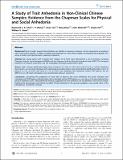A Study of Trait Anhedonia in Non-Clinical Chinese Samples: Evidence from the Chapman Scales for Physical and Social Anhedonia
Author(s)
Chan, Raymond C. K.; Wang, Yi; Yan, Chao; Zhao, Qing; McGrath, John; Hsi, Xiaolu; Stone, William S.; ... Show more Show less
DownloadChan-2012-A study of trait anh.pdf (124.4Kb)
PUBLISHER_POLICY
Publisher Policy
Article is made available in accordance with the publisher's policy and may be subject to US copyright law. Please refer to the publisher's site for terms of use.
Terms of use
Metadata
Show full item recordAbstract
Background:
Recent studies suggest that anhedonia, an inability to experience pleasure, can be measured as an enduring trait in non-clinical samples. In order to examine trait anhedonia in a non-clinical sample, we examined the properties of a range of widely used questionnaires capturing anhedonia.
Methods:
887 young adults were recruited from colleges. All of them were administered a set of checklists, including Chapman Scale for Social Anhedonia (CRSAS) and the Chapman Scale for Physical Anhedonia Scale (CPAS), The Temporal Experience of Pleasure Scale(TEPS), and The Schizotypal Personality Questionnaire (SPQ).
Results:
Males showed significantly higher level of physical (F = 5.09, p<0.001) and social (F = 4.38, p<0.005) anhedonia than females. As expected, individuals with schizotypal personality features also demonstrated significantly higher scores of physical (t = 3.81, p<0.001) and social (t = 7.33, p<0.001) trait anhedonia than individuals without SPD features, but no difference on self-report anticipatory and consummatory pleasure experience.
Conclusions:
Concerning the comparison on each item of physical and social anhedonia, the results indicated that individuals with SPD feature exhibited higher than individuals without SPD features on more items of social anhedonia than physical anhedonia scale. These preliminary findings suggested that trait anhedonia can be identified a non-clinical sample. Exploring the demographic and clinical correlates of trait anhedonia in the general population may provide clues to the pathogenesis of psychotic disorder.
Date issued
2012-04Department
MIT MedicalJournal
PLoS ONE
Publisher
Public Library of Science
Citation
Chan, Raymond C. K. et al. “A Study of Trait Anhedonia in Non-Clinical Chinese Samples: Evidence from the Chapman Scales for Physical and Social Anhedonia.” Ed. Marianna Mazza. PLoS ONE 7.4 (2012): e34275.
Version: Final published version
ISSN
1932-6203